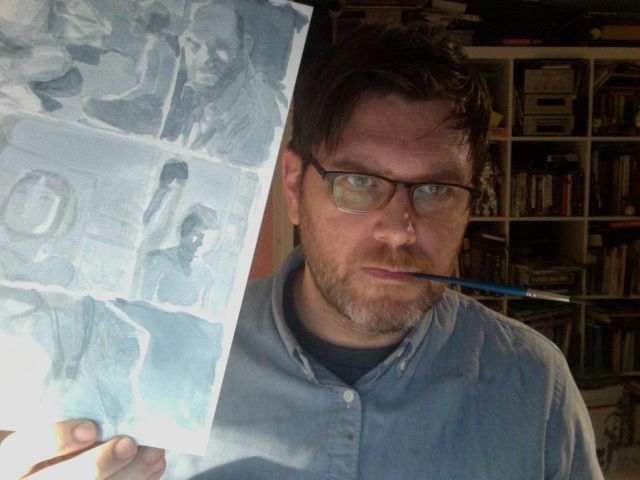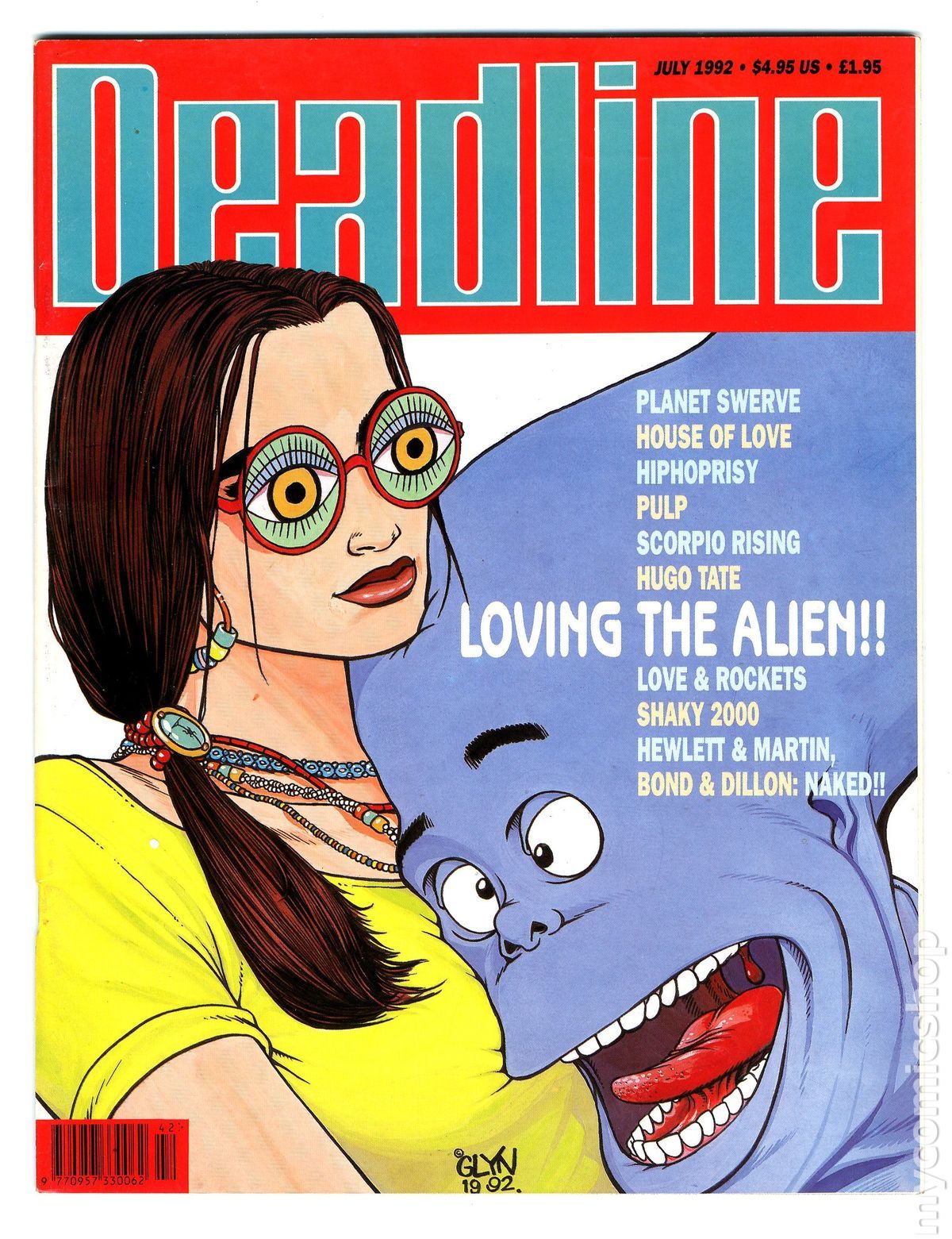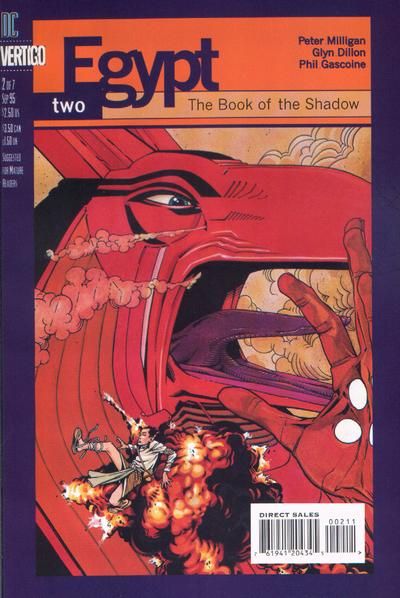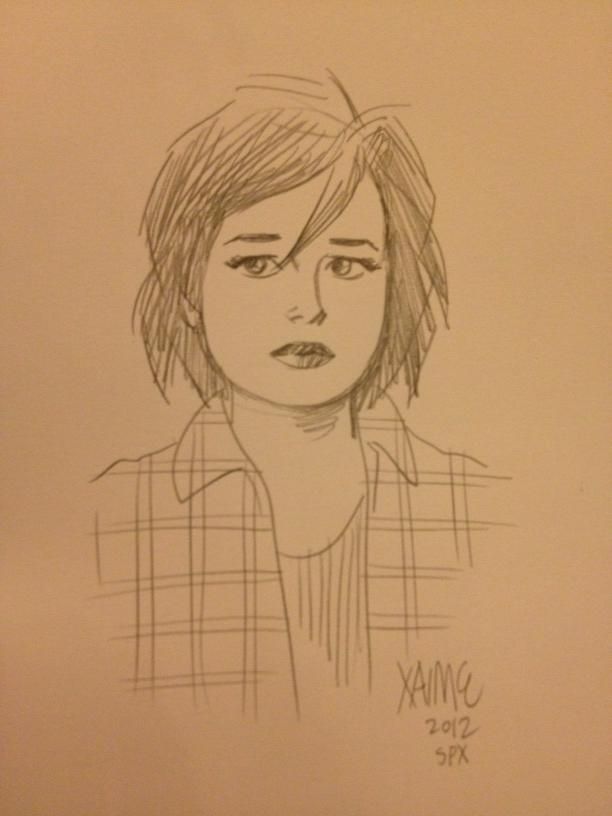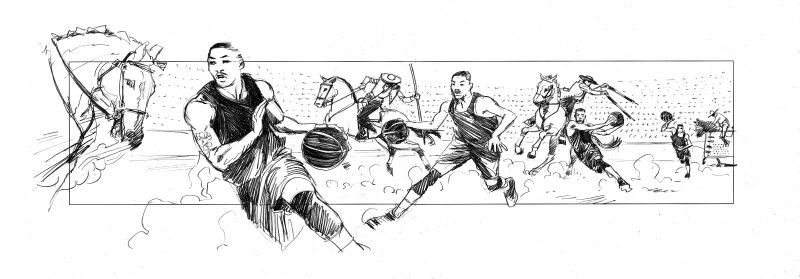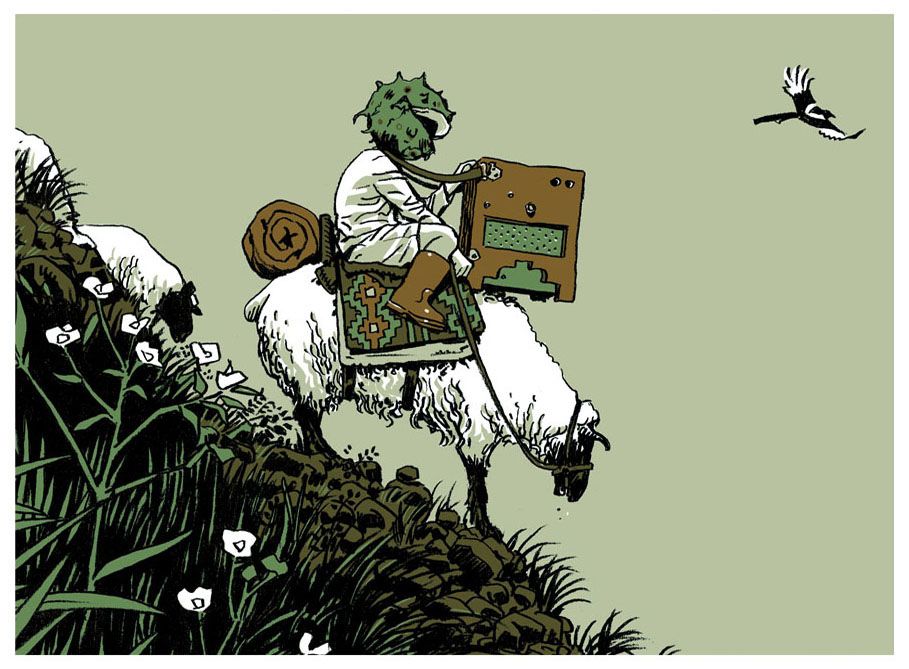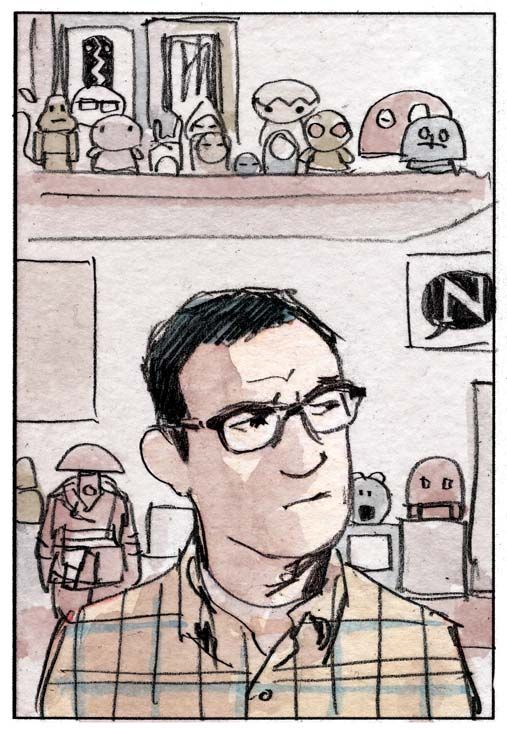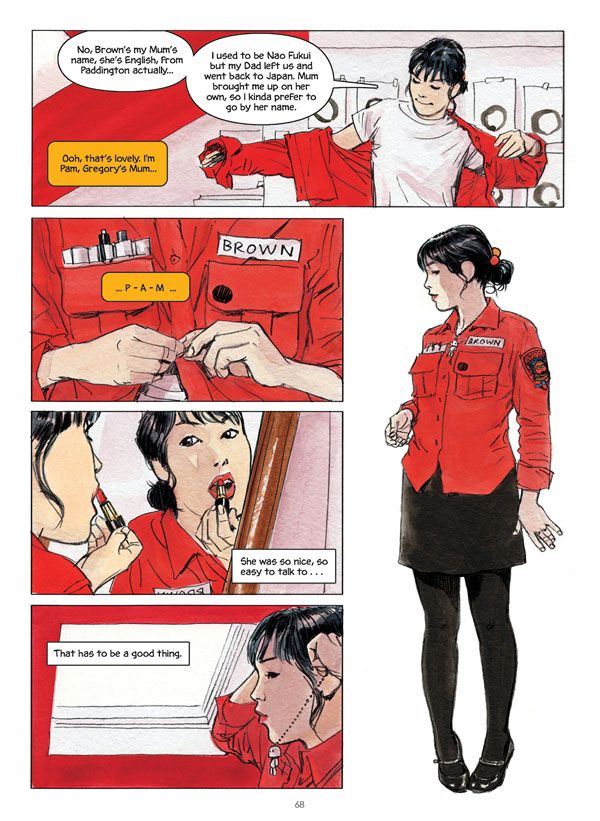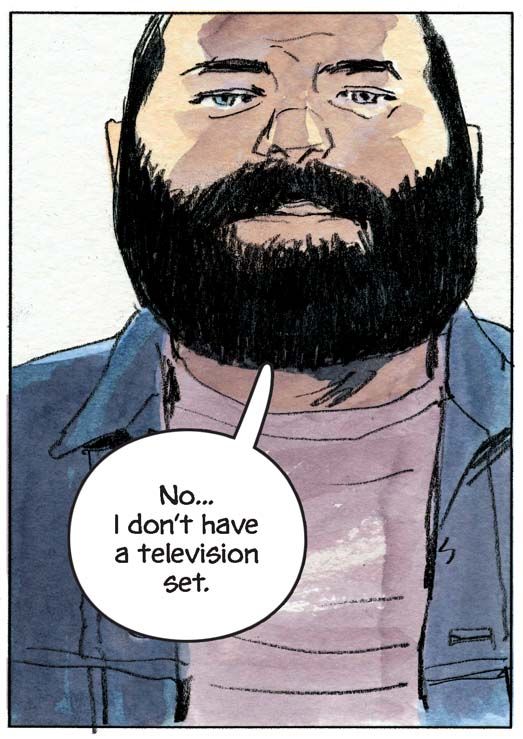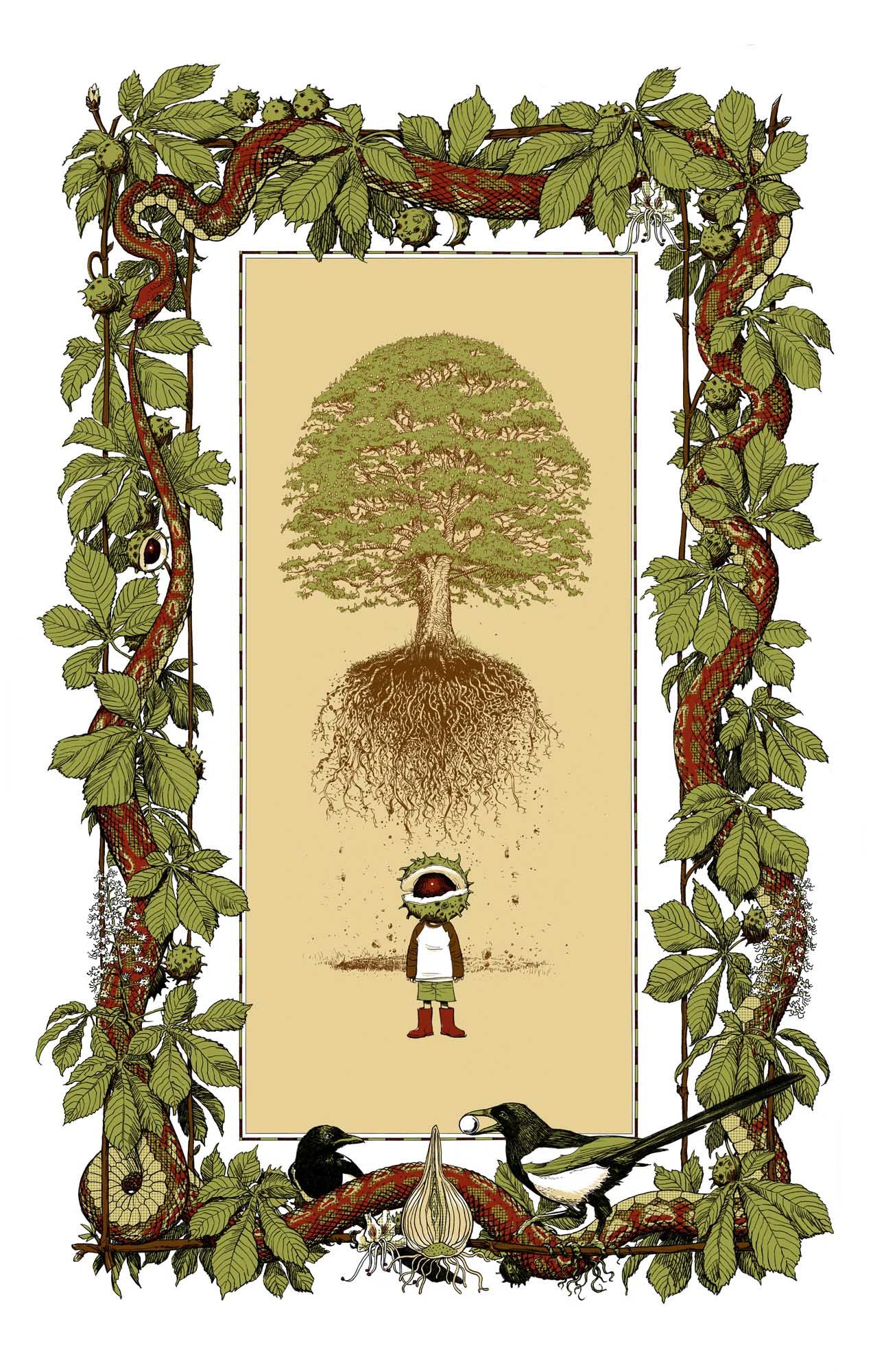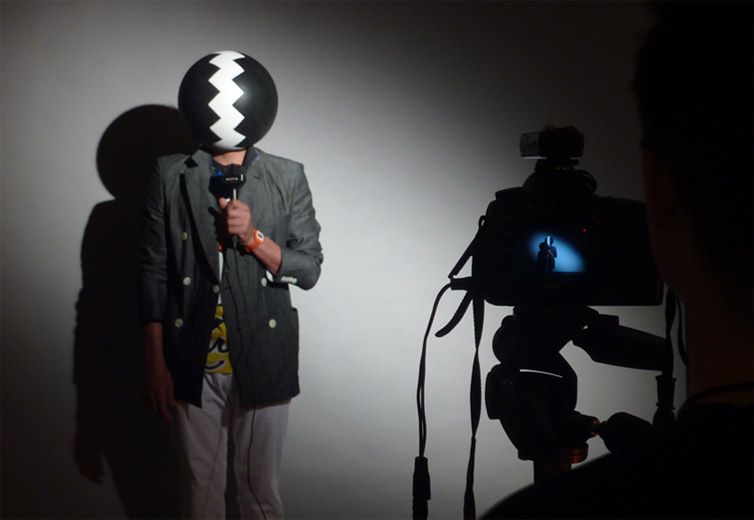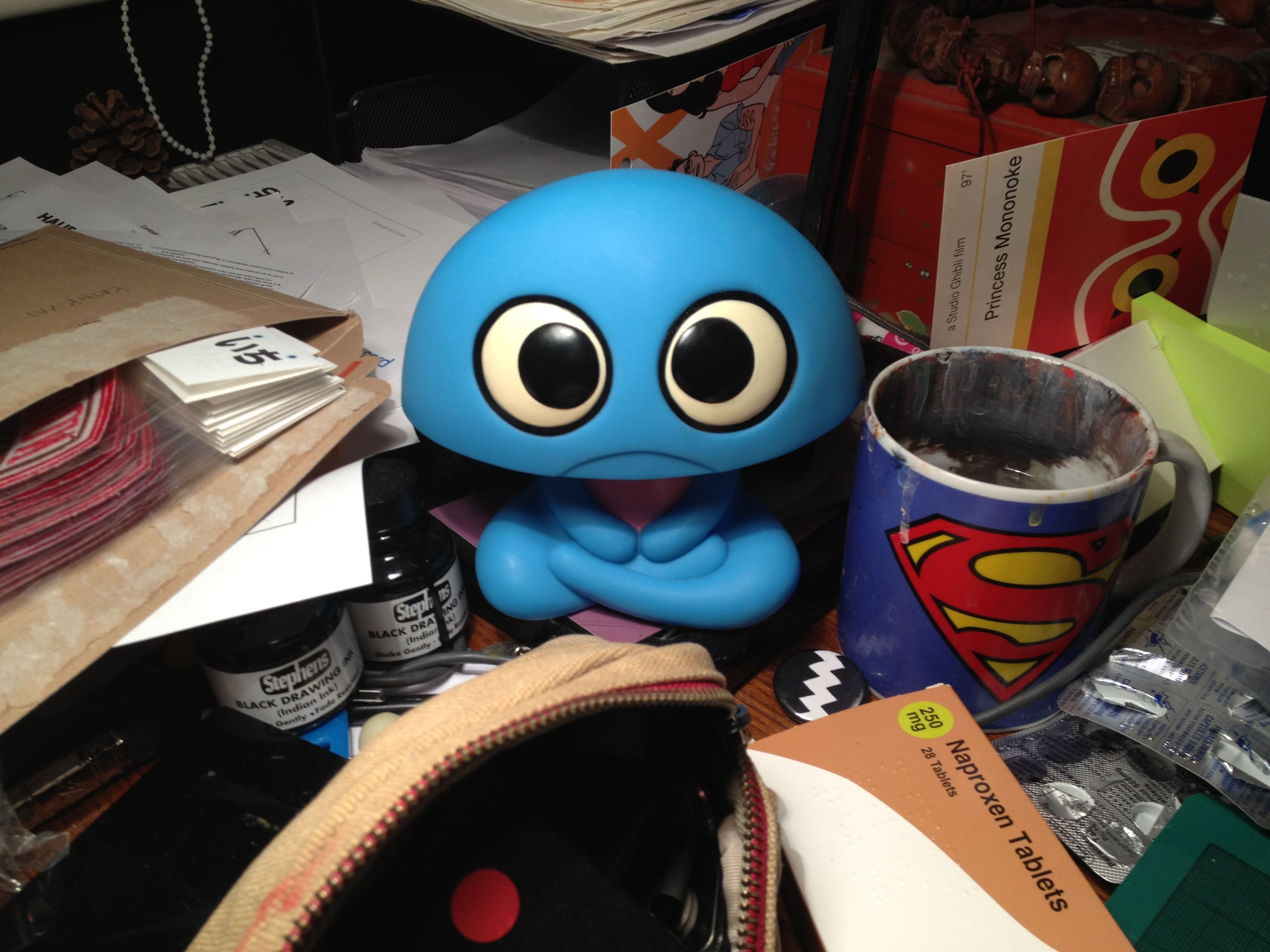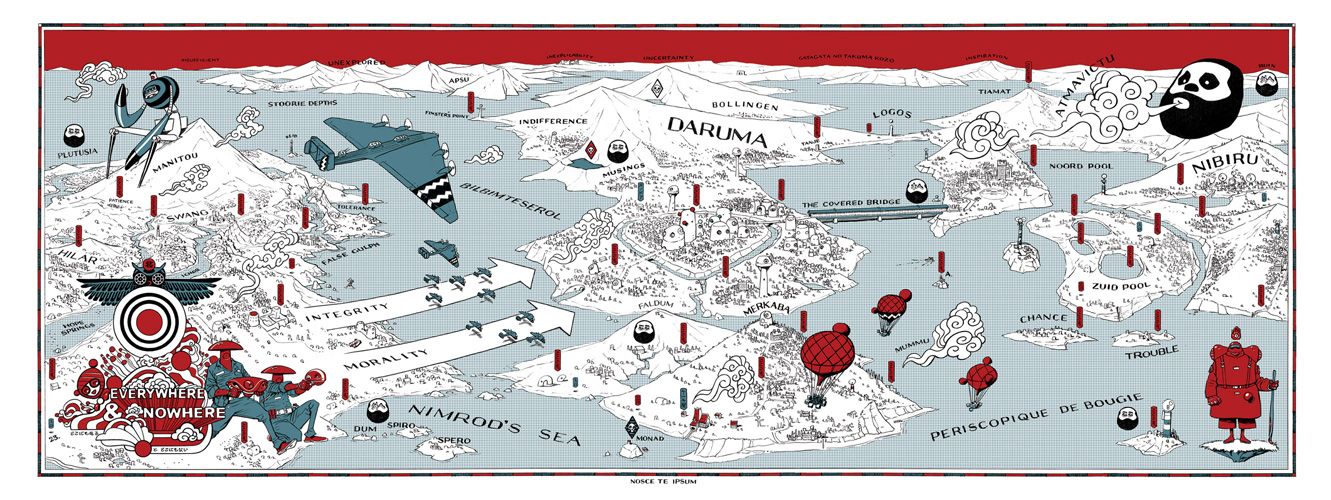A few years ago it seemed like Glyn Dillon might end up just a footnote in the histories of other comic creators: the younger brother of Steve; the housemate of Jamie Hewlett, Alan Martin and Phillip Bond during the Deadline years; the artist on Alan Martin's decidedly less-famous strip “Planet Swerve”; a collaborator with Pete Milligan on a few uncollected Vertigo comics. If you asked around, you found out that Glyn Dillon was part of the exodus of talent out of comics in the mid-'90s, a brain-drain that benefited the worlds of film and television production greatly.
If you were really tenaciously researching his creative whereabouts, you may well have discovered he now had an IMDb page publicly listing a few storyboarding jobs. In the immortal words of This Is Spinal Tap, to the average comic fan he was “currently residing in the where-are-they-now file." TV and film production is a litigious land where artists are bound by non-disclosure agreements; the thousands of pages they produce there may never be seen, at least not until the projects they are produced for are either in the can or officially pronounced dead. This is considered beyond the pale by comics fans, used to their favorite artists releasing practically every development sketch for every project they work on.
It therefore came as a surprise when a gallery of work by Dillon appeared in 2007 in the third volume of the comic art magazine Swallow. The work there was astounding: otherwordly, dreamlike imagery seemingly more influenced by the European and Japanese comic traditions than any of his U.K. or U.S. peers. Those unseen thousands of pages of storyboard and concept art had clearly influenced Dillon's drawing radically. In the short accompanying text we learned he was now back in London, and enthused to get all manner of projects off the ground – to start and edit a comics anthology; to produce toys, prints and t-shirts of his designs; that he was writing and drawing a children's book; that he had been selling original pieces through Santa's Ghetto, the pop-up art store Banksy opens in London's Oxford Street in the Christmas period.
Not terribly long after that, Dillon joined Twitter as "NaoBrown." He was working on a graphic novel, re-using ideas from the work he was intending to produce for the now not-happening anthology One. Imagery, and eventually penciled panels of the book's pensive-looking lead character started to appear in his tweets and via the project's workblog. In early 2010, it was confirmed that U.K. publisher Self Made Hero would be releasing the book The Nao Of Brown. Every successive panel Dillon revealed on Twitter only increased the anticipation of the U.K. comic community for the book. It was clearly shaping up to be a major work. The book arrived in the U.K. in late September, and officially in the U.S. on Oct. 1, and has had critics both sides of the Atlantic raving, with many announcing it early as their book of the year. Amazing artwork; a truly novelistic piece of storytelling, full of wisdom and compassion; and a book which is a beautiful artifact, a treat for those of a bibliophilic inclination. The cast of The Nao Of Brown are all seekers of one kind or another: we caught up with Glyn recently, asking him lots of intrusive questions about his own epic journey, from Deadline to Hollywood and ultimately back to comics.
Robot 6: So, if Steve turned comics pro on Hulk Weekly at the ridiculously young age of 16, what age were you then?
Glyn Dillon: Around 6 or 7.
What sort of influence did that have on you as a kid? He was a pivotal figure at the epochal Warrior a couple of years later, too.
It was massive. I think it's pretty normal, when there's a big age gap, to idolize an older sibling ... but when that older sibling starts drawing the Hulk, spaceships and other superheroes ... well, it was amazing, and he was bloody good, very, very talented from a very early age.
Your dad was an artist as well, wasn't he? What field did he work in? What did he think of comics?
My dad was a sign-writer by trade and he was also the guy they'd go to for pub signs, or if a big bar of soap was needed on the side of a van. All in the days before photographic enlargements. But he wasn't a working artist by the time I was growing up, he's just getting back to painting for pleasure now. What did he think of comics? He wasn't a reader of comics but he knew what he liked visually. I remember him saying, whilst I was reading something, that it was too messy: "If you can't tell what's going on when you look at it upside down, it's too messy." I think that's good advice.
I'm guessing with all this talent in the household, you must have been exposed to a wider cross-section of comics and art, and at an earlier age than the average child.
Yeah, I remember being a bit disturbed by some Robert Crumb comics at an early age, all hairy legs and trousers 'round ankles. But mostly the fact that there was a weekly influx of comics, as well as Steve's ever-expanding collection that he would buy, there was all the stuff he was working on that we would get for free! The Hulk Weekly, Doctor Who, 2000AD, Warrior. All great stuff.
Sneaking into my brother's studio when he wasn't there was a big thrill ... the smell of pencil shavings, Indian ink, used brushes and piles of paper. It all made a massive impression on me. I've wanted to be an artist ever since I can remember, and I still love to nosing around other people's studios, given half a chance.
You headed off to art college intending not to go into illustration but sculpture instead, is that right?
Well, I had a little rebellious streak for a while, in as much as, from the age of 6 I'd wanted to draw comics like my brother, then at around the age of 14-15 I thought, actually, maybe I might want to do something else. I wasn't very good with black and white at that age, I was far more comfortable painting and I also really liked sculpting. But I couldn't picture the reality of being a sculptor, so I was kinda heading back to the idea of drawing comics, when I met Jamie (Hewlett) Phil (Bond) and Alan (Martin) for the first time ... and they blew my mind. Atomtan and Circular Field, their two small-press efforts, just turned me right back onto comics again. And they were really nice guys, took me under their collective wing (they're all about three or four years older than me) and I ended up moving to Worthing at the earliest opportunity because of them.
Steve was clearly a heck of a catalyst for change in your life again when he started Deadline with Brett Ewins. I remember being at the Deadline first anniversary panel at UKCAC '89, and it looked like everyone there was having the time of their lives. It must have been fun, being young and right in the middle of a cultural phenomena as it's blowing up.
I was definitely having fun. The UKCAC conventions were notorious for their non-stop drinking sessions, so my memory of actual events is pretty limited. I've often been told what happened at them by people with better memories, but my recollection is very sketchy. As for being in the middle of a cultural phenomena, it just felt like we were all having fun in our small seaside town, entertaining each other more than anything else. I was too young to appreciate how great it was to be able to have a stupid idea in the pub with your mates, and then two weeks later that stupid idea was on the shelves in WHSmiths.
“Planet Swerve” by you and Alan Martin was a key part of what we could call phase two of Deadline. How do you feel about that work now? Looking at it now, I see an artist going through a rather fast learning curve. A few months in, and you were trying all sorts, montages, pastiches of Dan DeCarlo, Moebius ...
Not long ago I bought the copy of Deadline with the first "Planet Swerve" in it (I lost all my issues). I didn't enjoy looking at it at all, so I learned my lesson there, and have no intention of looking back on any more.
Memories are sometimes best kept as fuzzy. Me and Alan laughed a lot making Planet Swerve and I'd rather remember that, than have the hard evidence of bad drawing, printing mistakes and alien knobs in front of me. I still like the concept though, (art students in space) but I don't think it ever realized its full potential, we were too busy getting spaced with the local art students.
Like many at Deadline, you were being recruited increasingly for work at Fleetway and DC/Vertigo. Meanwhile, all the momentum at Deadline was dissipating, with many of the core creators there openly cynical about the direction of the magazine within their strips. How do you feel about that period now?
Again I was still really young, early 20s, and Deadline didn't pay well at all, so when DC/Vertigo came along, offering much bigger page rates it was a no-brainer. But more than just the money, I was getting to work with Peter Milligan, who I was a massive fan of, and still am.
So, by the mid-'90s, off into the worlds of TV and film, working for visionaries like Steve Barron, Jim Henson and Ridley Scott. Again, that must have been another tremendous learning curve. How did that period affect your drawing and storytelling chops?
I'm glad I went down that route, the intention was to end up directing myself, and I did manage to do a bit of that (not much). But the byproduct of trying to become a director via storyboarding meant I was doing a lot of drawing and a lot of story telling, but without an audience to be conscious o f... or having to worry about my "style." I was just drawing, fast and loose, in order to tell whatever story as clearly as possible. Excellent training for comics.
And then back to London, working again with Jamie, in a studio at a time when his star was again rising meteorically. What was that like, working on a cultural phenomenon of a different scale altogether?
Again, it doesn't feel like a cultural phenomenon when you're in the studio, it's just great to be sharing a studio with a bunch of mates. I didn't do a lot on the Gorillaz project anyway, just a few bits for the websites and some coloring for Jamie when he was snowed under, I was still freelancing and doing storyboards mostly. We did try and work up a big TV series project, then when that didn't work out we tried to get it up and running as a film, but it never came off (not yet anyway) ... That world is a tough nut to crack.
I remember you tweeting during the Gorillaz set at Glastonbury whenever the graphics you worked on came up, behind Damon and Yukimi Nagano's duet on "To Binge."
That's my favorite thing I've done, directing-wise. When Jamie offered up the idea of getting other people to do some visuals for the show, I jumped at the chance, specifically because of that track, I love it.
It was great to do something completely diametrically opposed to the usual Gorillaz visuals. Just the one shot for the whole song. But it took fourteen takes to get that one shot … we got through a lot of liquids that day.
And you've a cameo in a memorable scene in the Bananaz tour film, as Jamie rants at being stitched up by the NME.
Ah, Bananaz is great! And that was a particularly funny bit, I remember what they (the NME) did to that interview, it was awful.
Great film, though, Ceri Levy (the director) is ace.
The decision to get back on the comics horse. A gradual thing? An epiphany?
Well, kind of an epiphany, really. A combination of not being able to get TV or film projects off the ground without having to have endless meetings with 'money' people, and specifically, I remember after seeing the first Hellboy film, despite it being a pretty good adaptation, I realized I'd much rather spend the evening poring over Mike Mignola's artwork. From that point onwards I was thinking about comics again.
When I left comics, I was at a stage where I really wanted to collaborate, meet people, get 'out and about' (specifically out of Worthing) ... I was only then able to come back because I'd got all that out of my system. I was now happy to sit at home alone, for hours, days, weeks on end, I was ready to do that again ... and that's all it takes. That's the beauty of comics, you've only got yourself to rely on, and if you're willing to put the time and work in, you can end up doing something, finishing something.
As you know, for kicks I stalk the movements of most of the world's comic artists using Twitter, and noted that you were part of a growing U.K. contingent at this year's SPX. How'd that go?
I had a great SPX, thanks, met lots of great people, among them Jaime Hernandez, who's a complete hero of mine. It's been a long long time sine I attended a convention and had something in print. Back in the days of Deadline I don't remember us ever sitting behind tables all day like everyone does now. Seems a lot more civilized these days, but maybe that's just me.
We should probably talk about the quantum leap in your art style since readers would have last seen it in the mid-'90s. Obviously your technique is now radically different, but what about the newer influences you were exposed to in the interim.
To be honest, I wasn't exposed to too many new comic influences, I just drew an awful lot of storyboards in that time, and by doing so, a style developed that I was much more comfortable with. Back in the early '90s I was a big fan of Hugo Pratt, Moebius and Katsuhiro Otomo -- none of that has changed. But having said that, whilst I was writing the script for Nao, I started reading more manga and I think that may have had an effect on my storytelling to some degree. Manga is quite filmic and I suppose coming back after seventeen years of storyboarding for film and TV, I think that will have definitely had a big influence on how I tell stories compared to those early nineties efforts.
What about your writing influences? In the blurb on the back Jamie mentions Herman Hesse, and yeah, there's the similar eastern philosophical influence; like Hesse, your characters are similarly questing for self-knowledge (and Hesse was a pretty good watercolorist, too). I look at the structure of the book and see a little The Singing Detective or Brazil in there, too.
I'm a big Hesse fan, and he was definitely an important influence on this book; Carl Jung, too. Brazil is one of my all time favorite films but it wasn't a conscious influence on this, and neither was The Singing Detective, which to my shame I've not seen.
Are you a practicing Buddhist? Or just Dharma-curious?
I practice meditation and I learned to meditate at a Buddhist center similar to the one in the book. But it's not a Zen centre and from what I have read and practiced with regards Buddhism, I lean more towards Sōtō Zen Buddhism. But no, I wouldn't call myself a Buddhist, because by committing to such a label I feel I'd be closing the door in some way to other, as yet unknown options. Am I curious? Absolutely. I'm interested in Taoism, Gnosticism and alchemy, too, and really, from what I understand, they all share big similarities, I think they're all just different ways of trying to see the same thing.
I saw that Director's Commentary over at the FPI blog. Hey, rather than drawing with an HB pencil and darkening it on a photocopier or computer, why don't you just buy a 4B pencil? They only cost a couple of quid.
Well, a softer pencil will smudge more, get all over my hands and give a softer line. The hardness of a HB is very practical, gives a clean hard and fast line and when darkened in Photoshop is very similar to an inked line.
Similarly, you've spoken of being "liberated" from inking. Surely the fantasy sequences of the book are inked, right? It looks pretty accomplished to me.
Nope they're all HB pencil, darkened in Photoshop.
Woah. Well, Nao is a complete nutcase. Is she you? A conflation of people in your life? Or are you more of a Steve? Or a Gregory?
I wouldn't say Nao is "a complete nutcase." Although I know she refers to herself in a similar way on the first page. No, none of them are me. But having said that, all of them are created by me and I had to inhabit their character as best I could in order to write them. Some of their experiences have been mine and also some of my friends but I always tried to ensure it came across very much from the character's perspective.
I wanted to say that the characterization through the art, the "acting," as they say, is excellent. It's also something your brother's work is regularly praised for. A family trait, would you say?
I don't know, maybe. I think my brother is brilliant - obviously I'm biased but he was a massive influence on me as I was growing up. He has so much natural talent, it was quite something to grow up witnessing his career from close quarters.
For a novel about a woman suffering a major schizophrenic breakdown, where every character seems to be going through an existential crisis of some sort, there's a few belly laughs in there.
Nao's not schizophrenic, she suffers from POCD, which is Purely Obsessional Compulsive Disorder. But the only way you'll know this, is if you suffer with it yourself... Or if you read the dust jacket blurb. I didn't want it explicitly mentioned in the book.
My wife suffered badly with OCD when she was a child and into her late teens. At the same time that I was learning to meditate, I was beginning to learn about this (OCD), and all that stuff kind of went into the melting pot of ideas. Nao's OCD is not the same as my wife's, but she was an essential part of helping me understand the torment that OCD can cause.
I researched the condition by reading several books, online forums and I also went to a support group for sufferers and their families. I also got hold of as many films as I could that featured it in some way. One, called Dirty Filthy Love, starring Michael Sheen, is a good film and it does a great job of explaining exactly what OCD is, in all it's different forms, but, after seeing it, I knew that wasn't the kind of book I wanted to make. I wanted to make a book for someone who had OCD and didn't need it explaining to them. I didn't want Nao's condition to dominate the story to that extent or at least I didn't want the explaining of it to take over. As in Martin Scorsese's The Aviator, when I first saw that, I knew nothing about OCD, and I certainly didn't know Howard Hughes suffered with it, I'd just heard he was an eccentric recluse. I like the way Scorsese didn't try to explain the condition, instead he showed us it. So when I re-watched The Aviator having researched the condition more, it offered up new layers of depth and meaning. And I appreciate the fact that Scorsese trusted the audience with that, it made for a much more rewarding experience. With regards "belly laughs," well, I wanted there to be those moments, because life is never all dark, or all happiness and light. And although she suffers with what can sometimes be a completely crippling condition, which is a big part of her life -- it's not her whole life, and I wanted the story to reflect that.
Hope you weren't offended by my reference to Nao as a total nutjob.
Not at all, it was interesting, and if you don't know anything about OCD, she is gonna come across as a nutjob.
I did find her totally loveable and relatable. I also wanted to highlight the fact that you completely avoid at any stage in the book making her into cheesecake. A lot of your male peers have been praised for creating strong female characters - Alan and Jamie, Phil Bond, I'll even sling Jaime and Beto in that pile, despite a little age gap, but all of them have chucked in some dodgy gratuitous nudity into their work over the years.
Yeah, it would've been completely out of place with Nao. It wouldn't have served, or added to, the story in any way.
Some of the recurring imagery in the book predates the story of Nao, doesn't it? Gregory Pope appeared in Swallow #3 in 2007, and appears as a poster on the living room wall in the Gorillaz house in the DoYaThing video. Hell, you're selling merch with his face on it. It's like there's a personal visual language breaking through into the text. Can I ask what the Pope/The Nothing icon means to you?
Originally, the book was going to be a different beast all together, in it's very early incarnation it was all about Gregory, the washing machine repairman, he was the main protagonist and he was going to be the "ichi" fan and the two worlds were maybe going to collide in some way. Nao was to be his love interest, but once I decided that Nao would suffer with OCD, she became the more interesting character to me and things took off in a much different direction.
What's with the people with plants for heads?
Pictor, the conker-headed boy (the slang in the U.S., I believe is "buckeye") was originally an idea I had for a visual depiction of the Jungian theory of the collective unconsciousness. Each tip of the point representing an "individual" ... but when you follow the barb down from that sharp point, it's all part of the same thing, a whole, a barbed nut. It was an image I was playing with a long time before I thought of doing Nao.
Then the "Nothing" having been "shot down" was another idea that'd been lingering for a long time. And that Acer, the Japanese Acer is my favorite tree, I have a friend who has the biggest one you've ever seen in her garden (apparently they're often quite small), it's beautiful.
You've three lead characters, all going through personality crises, major or minor; all achieve a level of catharsis through extreme physical acts, four if you include Pictor's in the book-within-a-book. But they all achieve liberation. Is this the moral of the story? Self-knowledge only comes from a place of, or an act of, desperation?
It could be ... It's also a case of "Who knows what's good or bad" (the old Taoist parable) ... Which is a theme that kind of runs through the book. I suffered a nervous breakdown as I turned thirty, was in hospital for three months, a lot of people might say "How awful" but actually it was the best thing that ever happened to me. Maybe that experience is echoed in the book.
There's a fifth character, though: Gil Ichiyama, his presence felt in the “real” world of Nao, Steve and Gregory through his work. Can you tell us more about him? That's a pretty website he's got.
Well, he kind of echoes the main story too, he's "hafu," like Nao and his work, the 'ichi' manga/anime in some way holds up a wonky mirror to the events and characters in the primary narrative. Doing his website, with the help of Mike from the Gorillaz websites, was a lot of fun.
Vinyl toys: this demi-monde Nao and Steve inhabit. I don't know much about it myself, but the work exhibits a strong affection toward it. You've worked with Kid Robot in the past, and there's a toy coming out to tie-in with the book, right?
Yeah, I love toys. And I really liked the idea of things from the book becoming real and inhabiting this world, so that there'd be a strange, reality cross over. I'll never do a t-shirt with Nao, Gregory or Steve on, but I'm more than happy to create merchandise that exists in her world, stuff I know she would love.
Yes, there is a limited edition toy called Froglegs, which is based on one of the toys in the book. And there's also another figure in the works, which I can't say too much about yet, except that I'm really very very excited about it ... stay tuned.
Never mind the contents, the book itself is a work of art. As a bibliophile, I've got to point out that the packaging of the book is bloomin' glorious -- imagery on both sides of the dustcover, the debossing on the boards and spine, the sweet-smelling unbleached paper stock, the book edges dyed to match the endpapers. It's a sensory treat to behold. Was this aspect of the book something you had very definite ideas about?
Thanks. Yes. Definitely. I wanted it to be a beautiful object to hold, a very physical thing, something that "digital" could never deliver. The white book with the blood red 'insides' was inspired by a Japanese version of Shakespeare's Pericles we saw at the National Theatre in 2003, one of the costumes has stuck in my mind for years. It was a beautiful multi layered, very grand, white kimono, but underneath all the white layers there was one bright, blood red layer, that you would only ever catch fleeting glimpses of via the large cuff of her sleeve as she moved round the stage. This I found unbelievably beautiful. And it conjured up ideas of the dry, paper-like pure skin, that beneath it, housed the dark wet, blood and guts of the innards. ... Two opposites coexisting in harmony.
The "Pleroma" map, hidden on the inside, again was something I wanted to do from the very beginning. I love maps, I've got some great books on maps, one in particular called "You Are Here, Personal Geographies & Other Maps of The imagination" by Katherine Harmon. It has lots of old beautiful and unusual maps, like ... "Falls of Eternal Despair" and "A Map of the Various Paths of Life" ... all these maps are of the inner "geography." So it made sense for my map, which is of a similar nature, to be hidden at first glance, yet still discoverable. And I also love that classic children's book tradition of having a Neverland-style map at the beginning of the book.
SelfMadeHero were great about all this stuff, never once did they try to dissuade me from these, probably quite expensive processes. And I'm really grateful to them for that because I think it really makes the book.
Nao of Brown's been a long time on your plate, with your workblog for it starting in late 2008. How does it feel to have finally finished it?
Well, it's funny, it doesn't feel finished in some ways, because doing things like this interview feels all part of the same process. I'm preparing some stuff for the launch, working on a website still, all these things are part of the project, it just feels like I've moved into a different phase of the same thing.
But yeah, the first time I held the book in my hands that was pretty amazing... and the fact that it was all exactly how I wanted it, design-wise (which was really important to me) ... and there were no printing mistakes, despite there being a double-sided dust jacket etc. ... I couldn't be more pleased about all that stuff coming off.
That was the best feeling.
Which then rather begs the question, what next?
Sorry, no idea.
At the moment I can't really afford to do another project like that. We'll see. ... I have some very loose ideas ... and there is an adaptation I've always wanted to do. I'm just gonna try and enjoy this phase for now. We'll see, I need something to grab me like Nao did. But maybe expanding the 'ichi' universe might be fun too, if it gets a good reaction.
Man, that'd be brilliant. Glyn, thanks for your time, and best of luck with whatever the future holds.

